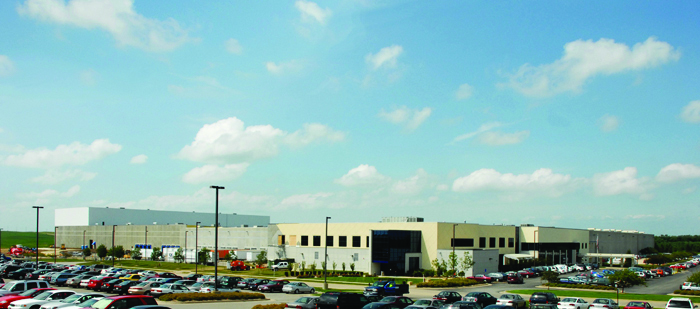
The Nordstrom fulfillment center at 7700 18th St. SW, Cedar Rapids, fills orders from Nordstrom.com, trunkclub.com and Nordstrom in a building with more floor space than 10 football fields. PHOTO/NORDSTROM
By Dave DeWitte
[email protected]
Editor’s Note: This is the first in a four-part series on retail in the Corridor.
If you stand outside the doors of the largest single retail operation in the Corridor, you’ll see an intermittent flow of vendors, delivery trucks and employee vehicles.
What you won’t see is customers. They’re at home or at their businesses, waiting for their orders of Zella leggings, La Mer moisturizing cream and David Donahue dress shirts to be delivered to their doorsteps.
The largest retail operation in the Corridor isn’t a big-box Walmart, Costco or Menards store. It’s the 614,000-square-foot Nordstrom Direct fulfillment center that sits on 46 acres of rolling prairie on 18th Street SW in Cedar Rapids.
Between 1,700-2,000 Corridor workers report to the center daily depending on the season, processing and picking orders from high-stack inventory bins and shipping them on behalf of Nordstrom Direct, Nordstrom stores and the Nordstrom-owned e-tailer, Trunk Club.
Nordstrom is ranked by eMarketer magazine as the 10th largest e-commerce company in the United States, with online sales of almost $2.7 billion. E-commerce makes up nearly 19 percent of Nordstrom’s total sales, according to the publication.
The company also brings tens of millions of dollars of annual payroll into the Corridor, even though its nearest store is more than 100 miles away in West Des Moines. In terms of economic activity, the fulfillment center generates more than many Nordstrom stores combined.
“The fastest growing segment of our business is the e-commerce piece, and that is the most volatile segment,” President Jamie Nordstrom said on the company’s third-quarter conference call with Wall Street analysts.
Nordstrom spokeswoman Jessica Canfield said the fulfillment center is a continuous work in progress. It was expanded in 2004 to add a customer contact center, and in 2008 to add space for day-to-day operations.
“We’ve designed the space and our processes to be optimized for continuous improvement so we can continue to evolve with our customers’ expectations,” Ms. Canfield said. “Specifically, this has allowed us to speed up shipping on customer orders, which we know is increasingly important.”
Nordstrom declined to say how many orders it ships from the center each year, but Ms. Canfield confirmed that sales volumes supported by its Cedar Rapids fulfillment center grow each year – a trend it expects to continue with the growth of online and mobile shopping.
E-commerce sales outpaced sales at existing Nordstrom stores by a compelling margin in the first nine months of 2016. Sales by Nordstrom.com made their way to a double-digit increase of 10.3 percent for the period, compared to a decline of 6.3 percent for full-line Nordstrom stores, and an increase of 0.4 percent at Nordstrom Rack, the company’s limited-line, off-price stores.
The Seattle-based company added a huge fulfillment center less than two years ago in Elizabethtown, Pennsylvania, to keep up with e-commerce orders and improve service to points east of its existing fulfillment centers in Cedar Rapids and San Bernardino, California.
While they continue to work to attract brick-and-mortar retailers, local officials have high hopes of landing another Nordstrom-like fulfillment center following last year’s unveiling of the Big Cedar Mega Park by Alliant Energy. The planned 1,300-acre industrial park is more than twice as large as the 582-acre Cedar Rapids Land and Air Super Park located just south of the Eastern Iowa Airport, previously the state’s largest project-ready Certified Site.
“The new Alliant park is really an inland port,” Cedar Rapids Council Member and Skogman Commercial real estate specialist Scott Olson said. “It will bring in shipping containers, unload them and distribute their contents.”
Mr. Olson pointed out that e-commerce isn’t just the province of a few big players, and that a large cross-section of retailers include an online component in their business model.
The trend has even influenced the style of new industrial buildings being constructed across the country, including here in the Corridor, Mr. Olson said. Distribution facilities are now optimized inland-port style, with 360-degree access and a multitude of loading docks to minimize loading and unloading delays. They have high ceilings and large open bays to allow the installation of high-stack inventory bins with automated picking systems, and they have robust internet connections to allow for reliable and rapid order processing.
The Amazon effect
United States e-commerce sales grew 15.4 percent from the third quarter of 2015 to the third quarter of 2016, according to the U.S. Commerce Department, reaching an estimated $101.2 billion, or 8.4 percent of total sales. Over the same one-year period, total retail sales increased a more modest 2.2 percent.
Just one e-commerce player, Amazon, dominates the e-commerce field. Amazon owned 46 percent of all the nation’s e-commerce sales in 2016, according to Slice Intelligence, totaling an estimated $131 billion of annualized revenue.
What’s shocking about Amazon’s most recent sales figures is that the company was actually expected to lose market share in the fourth quarter to perennial also-rans in the online retailing game, such as Walmart and Target. The online giant’s actual results for the year were set to be reported just after press time.
Amazon voluntarily began charging Iowa sales tax in January, a move that would have been required if it had opened a “nexus” or physical transaction center in the state.
Some observers think it could mean the company is planning to open one of its own goliath fulfillment centers in the state, as it has been adding centers across the country to shorten distribution routes, Mr. Olson said. A single fulfillment center slated to open later this year in Sacramento will employ 1,500.
But the move could also suggest Amazon is entering Iowa with its latest spin on brick-and-mortar retailing: the cashier-less Amazon Go store. The small stores eliminate the expense of having cashiers and save customers from a time-consuming checkout experience.
As shoppers walk into the stores, they call up an Amazon Go app on their smartphone and hold it up to a scanner to open an admission gate. Amazon’s technology registers anything they pick up and take with them, and charges them after their departure.




